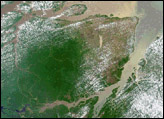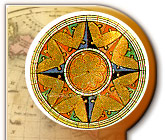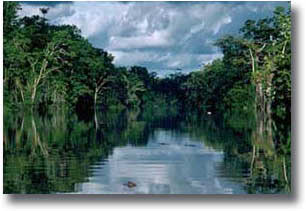
|
|
The
Lost Golden City of Manos
|
||||||||||||||||||||||||||||||||||||||
|
Beau's Notes: LANDS OF ROMANCE was a magazine published by some of the same group of Oklahoma City publishers that printed Louis book of poetry, Smoke from this Altar. It had hoped to be a competitor to National Geographic but lasted only a few years. The Lost Golden City of Manos was one of a series of travel articles that Louis wrote for LANDS OF ROMANCE during the days when he was first struggling to make a living as a writer. Back then, Louis was billing himself as a writer of adventure stories, and building a reputation as someone who had both studied about, and traveled in many exotic environments. The LANDS OF ROMANCE series gave Louis a terrific opportunity to build that reputation. In Louis L'Amour's Lost Treasures we will present the entire series. |
After Columbus came the conquistadors, those swash- buckling adventures who thronged to the New World on the heels of the Genoese navigator. With their pointed beards and rapiers, their prancing horses and glittering armor, they rode into the black wilderness of unknown lands as though to a knightly tourney. A thousand legends, gave them enchanting visions of the vast wealth to be won by valor. Whatever else these adventurers may have had, they did possess all the color and glamour one usually associates with adventure. In Mexico and Peru they destroyed civilizations of greater cultural value than their own, they looted and killed with abandon, and thought of nothing but gold. De Soto and Coronado sought for the legendary Seven Cities of Cibola. Ponce de Leon sought the Fountain of Eternal Youth.
De Soto found a dark grave in the waters of the Mississippi; Coronado found wide, unbroken prairies; Ponce de Leon found misfortune, death, and at last a grave on Puerto Rico. It remained for Cortez and Pizarro alone to find the gold they sought. Cortez, landing on a swampy coast of southern Mexico, found a great civilization with temples and cities, a religion and a court. Like Caesar the conquistadors came, saw, and conquered, leaving behind them a trail of looted cities drenched with the blood of native peoples. But the stories of the vast wealth they found remained to haunt the imagination of all who still possess a spirit of adventure. Montezuma gave to Cortez, among many other vast treasures, a disk of gold as large as a cartwheel, computed to be worth more than a quarter of a million dollars.
In Peru, Pizarro found even greater treasures, and another civilization, distinct from that of the Aztecs. A civilization ruled by an Inca, where no poverty was known, where they had cities, bridges, and extensive irrigation projects. Pizarro captured the Inca and held him for a ransom that would have caused present day kidnappers to turn as green as corroded gold. Pizarro was offered a room full of gold, a room twenty-two feet long, seventeen feet wide, and filled to a height of nine feet. This vast treasure was estimated at no less than fifteen and a half million dollars!
All of which proves that there was gold in those countries--that
great civilization mined and stored that gold, leaving the belief
that if such great treasures were freely given, still greater ones
remained hidden. And thus is blazed the trail for the story of the
lost City of Gold.
 THE MOUTH OF THE AMAZON While the Amazon is surpassed in length by the Nile, it carries the largest volume of freshwater in the world, accounting for nearly 20 percent of the Earth's discharge into the oceans. Millions of cubic feet of water empty into the Atlantic every second, and the effluent is transported across very large distances from shore. You can actually dip fresh water out of the ocean up to 200 miles off shore! |
LOUIS L'AMOUR'S LOST TREASURES
Member Login
| SUBSCRIBE NOW! |
What's in the Next Issue!
Preview Table of Contents | Forget Your Password?
About Lost Treasures | Frequently
Asked Questions | Contact Us
Copyright Notice | Terms
of Use Agreement
The
Official Louis L'Amour Web Site
Home | The
Louis L'Amour Trading Post | About
Louis | Louis
L'Amour Community
The Official
Louis L'Amour Discussion Forum










 Prologue
Prologue
 This
is not the forest. This is something threatening, something evil,
something ominous with unknown danger. This is something fever-haunted
and poisonous, streaming in the tropical heat of Brazil, a bizarre
pageant of exotic beauty suspending a veil over lurking death. This
is the jungle. The jungle as it must have been in those dim, prehistoric
ages when great reptiles roamed the earth. Here, even now, there
is but one law: the bloody rule of claw and fang. It is a court
of no appeal. The coils of a great snake, the jaws of a giant saurian
whose snout seems no more than the end of a sunken log in the muddy
water; the creeping jaguar or the more insidious death of fever,
all await the wanderer whose temerity leads him to dare these strange
wildernesses. Birds of gorgeous plumage flit through the trees overhead,
and somewhere off in the distance there is the crashing of a giant
tapir as he bolts through the jungle.
This
is not the forest. This is something threatening, something evil,
something ominous with unknown danger. This is something fever-haunted
and poisonous, streaming in the tropical heat of Brazil, a bizarre
pageant of exotic beauty suspending a veil over lurking death. This
is the jungle. The jungle as it must have been in those dim, prehistoric
ages when great reptiles roamed the earth. Here, even now, there
is but one law: the bloody rule of claw and fang. It is a court
of no appeal. The coils of a great snake, the jaws of a giant saurian
whose snout seems no more than the end of a sunken log in the muddy
water; the creeping jaguar or the more insidious death of fever,
all await the wanderer whose temerity leads him to dare these strange
wildernesses. Birds of gorgeous plumage flit through the trees overhead,
and somewhere off in the distance there is the crashing of a giant
tapir as he bolts through the jungle.
